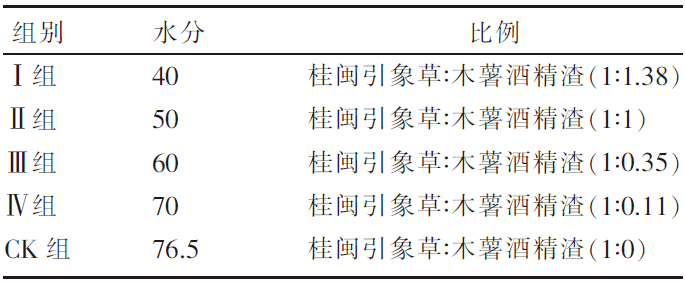| [1] |
李孟伟, 杨承剑, 彭开屏, 等. 添加不同物料对象草青贮品质影响的研究[J]. 家畜生态学报, 2019, 40(6):33-37.
|
| [2] |
谢华德, 郭艳霞, 彭丽娟, 等. 不同混合比例对象草与甘蔗梢青贮发酵品质及体外干物质消化率的影响[J]. 饲料研究, 2021, 44(12):93-96.
|
| [3] |
CHENG Q, LI P, XIAO B, et al. Effects of LAB inoculant and cellulase on the fermentation quality and chemical composition of forage soybean silage prepared with corn stover[J]. Grassland Science, 2021, 67(1): 83-90.
doi: 10.1111/grs.v67.1
|
| [4] |
LI P, ZHANG Y, GOU W, et al. Silage fermentation and bacterial community of bur clover, annual ryegrass and their mixtures prepared with microbial inoculant and chemical additive[J]. Animal Feed Science and Technology, 2019, 247:285-293.
doi: 10.1016/j.anifeedsci.2018.11.009
|
| [5] |
字学娟, 李茂, 周汉林. 不同处理对王草青贮品质及其体外消化率的影响[J]. 家畜生态学报, 2012, 33(2):65-70.
|
| [6] |
FERRARETTO L F, TAYSOM K, TAYSOM D M, et al. Relationships between dry matter content, ensiling, ammonia-nitrogen, and ruminal in vitro starch digestibility in high-moisture corn samples[J]. Journal of Dairy Science, 2014, 97(5):3221-3227.
doi: 10.3168/jds.2013-7680
|
| [7] |
刘中华, 李强, 冯志, 等. 发酵木薯酒精糟对生产猪生产性能及营养物质消化的影响[J]. 饲料工业, 2017, 38(10):26-30.
|
| [8] |
王林, 孙启忠, 张慧杰. 苜蓿与玉米混贮质量研究[J]. 草业学报, 2011, 20(4):202-209.
|
| [9] |
琚泽亮, 赵桂琴, 覃方锉, 等. 含水量对燕麦及燕麦+箭筈豌豆裹包青贮品质的影响[J]. 草业科学, 2016, 33(7):1426-1433.
|
| [10] |
张丽英. 饲料分析及饲料质量检测技术[M]. 2版. 北京: 中国农业大学出版社, 2003.
|
| [11] |
韩雅珊. 食品化学实验指导[M]. 北京: 北京农业大学出版社, 1992.
|
| [12] |
PLAYNE M J, MCDONALD P. The buffering constituents of herbage and of silage[J]. Journal of the Science of Food and Agriculture, 1966, 17(6):264-268.
doi: 10.1002/(ISSN)1097-0010
|
| [13] |
傅彤. 微生物接种剂对玉米青贮饲料发酵进程及其品质的影响[D]. 北京: 中国农业科学院, 2005.
|
| [14] |
李海涛, 姚开, 贾冬英, 等. 木质素含量的检测方法[J]. 皮革科学与工程, 2011, 21(2):31-34.
|
| [15] |
陈影, 卢宗梅, 张琳, 等. 发酵饲料分析检测技术[J]. 当代化工, 2019, 48(9):2060-2063.
|
| [16] |
青贮饲料质量评定标准(试行)[J]. 中国饲料, 1996(21):5-7.
|
| [17] |
滕明德, 莫新良, 王先桂. 盐化-减压浓缩-高效液相色谱法测定酱香白酒中乳酸和乙酸的含量[J]. 理化检验(化学分册), 2022, 58(10):1225-1227.
|
| [18] |
柳俊超, 姜俊芳, 宋雪梅, 等. 青贮饲料中主要有机酸的高效液相色谱分离分析[J]. 畜牧与兽医, 2015, 47(10):47-52.
|
| [19] |
徐晨东, 易蕴玉, 全文海. 利用苯酚-次氯酸盐反应测定铵离子方法的探讨[J]. 无锡轻工大学学报, 1998, 17(1):34-38.
|
| [20] |
杨胜. 饲料分析及饲料质量检测技术[M]. 北京: 北京农业大学出版社, 1993.
|
| [21] |
苗芳. 同/异质型乳酸菌对玉米青贮品质及有氧稳定性的影响[D]. 石河子: 石河子大学, 2017.
|
| [22] |
陶旭雄. 添加柠檬酸渣对象草和紫花苜蓿青贮发酵品质及有氧稳定性的影响[D]. 南京: 南京农业大学, 2019.
|
| [23] |
ELGHANDOUR M M Y, VALLEJO L H, SALEM A Z M, et al. Moringa oleifera leaf meal as an environmental friendly protein source for ruminants:Biomethane and carbon dioxide production, and fermentation characteristics[J]. Journal of Cleaner Production, 2017, 165:1229-1238.
doi: 10.1016/j.jclepro.2017.07.151
|
| [24] |
田静, 尹祥, 樊杨, 等. 晾晒、添加物及不同温度对象草青贮发酵品质和微生物的影响[J]. 草业学报, 2022, 31(7):76-84.
doi: 10.11686/cyxb2021245
|
| [25] |
赵明坤, 裴成江, 余昌培. 添加玉米粉对金荞麦和甜象草混合青贮品质的影响[J]. 贵州畜牧兽医, 2022, 46(3):17-19.
|
| [26] |
李静, 玉柱, 孙启忠, 等. 添加玉米粉对甜菜渣青贮品质的影响[J]. 中国饲料, 2008(23):15-17.
|
| [27] |
刘洋, 孙群香, 田丹, 等. 苜蓿鲜草与统糠、麦麸混合青贮对青贮料理化性状与营养品质的影响[J]. 饲料研究, 2019, 42(10):71-73.
|
| [28] |
吕建敏, 胡伟莲, 刘建新. 添加酶制剂和麸皮对稻草青贮发酵品质的影响[J]. 动物营养学报, 2005, 17(2):58-62.
|
| [29] |
徐生祥. 山毛豆和甜象草混合青贮饲料品质的研究[D]. 南宁: 广西大学, 2017.
|
| [30] |
庄益芬, 廖惠珍, 陈鑫珠, 等. 象草与玉米秸秆混合青贮效果的研究[J]. 草业科学, 2012, 29(6):1002-1006.
|
| [31] |
张心钊. 燕麦草与稻秸混合裹包青贮制作及其对湖羊瘤胃发酵、生长性能和羊肉品质的影响[D]. 扬州: 扬州大学, 2021.
|
| [32] |
孙鏖, 邓荟芬, 易康乐, 等. 燕麦秸-稻草混合青贮的研究[J]. 家畜生态学报, 2013, 34(10):48-50.
|







